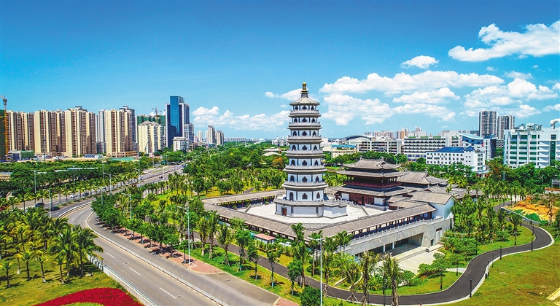
Source:HICN
As an island, Hainan is (obviously) surrounded by water. Be it now or back in ancient times, boats have been a critical mode of transportation, as well as means of making a living for fisherfolk on Hainan. Considering this, the lighthouses that dot the coast are as crucial to boats as eyes are to human beings. Although the modern concept of "marine navigation towers" didn't exist in ancient times, the many ancient towers that stood in the coastal areas of Hainan once played a role in guiding ships out at sea. Some of these towers still stand today.
Part.1 Mingchang Tower - the accidental beacon

Mingchang Tower. [Photo: Zhang Mao / Hainan Daily]
Originally built in the Ming Dynasty, the Mingchang Tower is located in the Guoxing neighborhood of Haikou's Qiongshan District near the Meishe River. The original tower, a wood and brick structure, had seven stories and a height of thirty-four meters, making it the tallest building in northern Hainan during the Ming Dynasty and earning it the moniker "the No. 1 Tower of Qiongzhou."
The Mingchang Tower was not built to guide ships. However, towering over the surrounding buildings, its height contributed to it taking up this role. The Qiongzhou Strait was easily visible from the top of the tower, as was the tower from boats passing across the strait. Though not meant for this purpose, the tower was perfectly suited to serving as a landmark for those crossing the strait.

Mingchang Tower. [Photo: Chen Weidong / Hainan Daily]
Similarly, the Wenbi Tower in the eastern suburbs of Wenchang ended up becoming a navigation aid. Built in the ninth year of the Guangxu Emperor’s reign in the Qing Dynasty (1883) as a feng shui (geomantic) tower, it was named for its slender and elongated pen-like body. The tower was constructed from brick and stands twenty-five meters high. Like the Mingchang Tower, it is octagonal in shape and has seven stories, though there are no stairs leading to the top. The tower is visible from the sea to local fishermen and other boats sailing into Qinglan Port.
Part.2 Doubing Tower - a talisman to ward off disaster

Doubing Tower in 2018. [Photo: Li Xinghuang / Hainan Daily]
The Doubing Tower, located on the main peak of Qixing Ridge in the northeast of Puqian Town in Wenchang, was built in the Ming Dynasty. The Qiongzhou Strait lies to the north of Qixing Ridge, and when the weather is clear, you can make out the coast of Xuwen County in Guangdong on the other side of the strait from the top.

Nearby are two busy ports with boats coming and going all the time: Mulan Port, which was also known as "Shilan Port" in ancient times, and Puqian Port, which has been a fishing and commercial port for centuries and occupies an eminent position in the history of shipping in Hainan.
Prior to the advent of modern navigation technology, the sea around Mulan Port north of Qixing Ridge was treacherous and accidents frequently happened. Thus, the ancients believed that it was necessary to build a feng shui tower here to quell the tides and ensure safe passage. Though the jury is still out on the efficacy of feng shui, the tower still managed to achieve its builders' aim by providing a navigation aid to those out at sea.

The stepped tower, which decreases in circumference as it increases in height, has seven stories and stands twenty meters tall. Each story has archways, and inside the tower is a spiral staircase with over 100 steps offering access to the top.
Doubing Tower is not only a beacon but a masterpiece of ancient architecture in Hainan that has stood for hundreds of years against the winds, rains, and tides.
Part.3 Xisha Lighthouse – an upcycled beacon

Xisha Tower. [Photo: Fu Neng / Hainan Daily]
Off the coast of Xisha Village (also known as Longsha Village) in Eman Town north of Danzhou City, there is an ancient lighthouse called "Xisha Lighthouse".

Another example of a structure with a former use, this lighthouse was originally used as a beacon for relaying military intel and orders in ancient times. After the tower was abandoned, locals began hanging lanterns on the tower, transforming it into a lighthouse for navigation purposes.
The main body of the tower is made of volcanic rock and is divided into three layers. The lower and middle layers are comprised of many rectangular carved blocks, while the top of the structure is composed of a single large carved capstone.

Nearby villages, including Xisha Village and Yanding Village, used to be in the salt-making business. Villagers would make salt at home that would then need to be transported by ship to the coast of Guangxi across the Beibu Gulf or other parts of Hainan. The villagers hung lanterns on the Xisha lighthouse presumably to ensure the safe passage of their salt-laden cargo boats.
In modern times, Hainan's shipping industry has become increasingly developed, and navigation beacons are deployed with increasing frequency. Modern marine navigation towers such as Lingao Cape Lighthouse, Xiuying Lighthouse, and Mulan Lighthouse have been built on Hainan's coast. These towering edifices, ancient and modern alike, stand as milestones marking the journey of the Hainanese people embracing the sea and going out into the world.
Copyright The People's Government of Hainan Province. All Rights Reserved.
Approved by: General Office of Hainan Provincial People's Government.
Qiong ICP License No. 05000041-1
Government Website Identification Code: 4600000001
Qiong Computer Information Network International Internet Unit 46010802000004